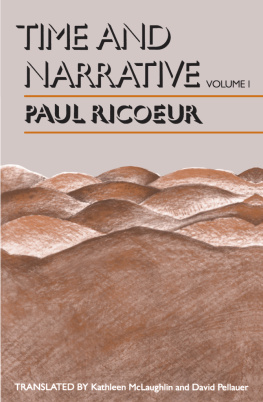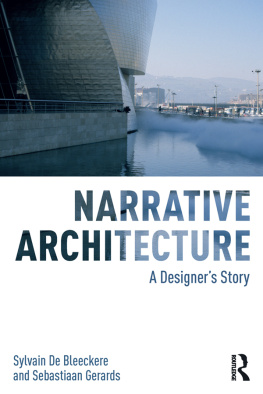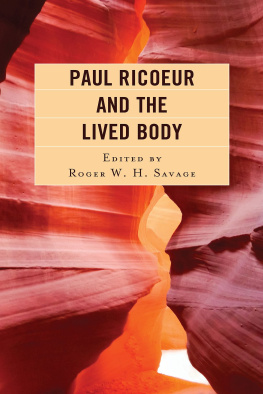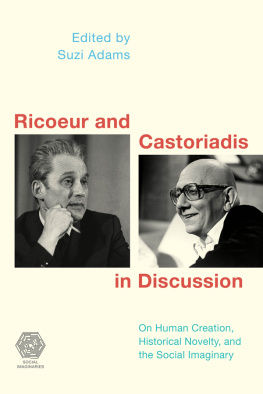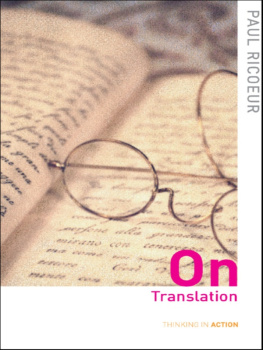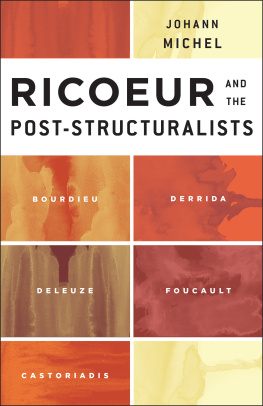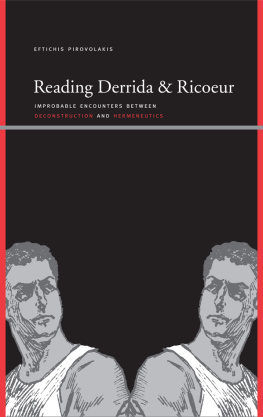Paul Ricoeur - Time and Narrative
Here you can read online Paul Ricoeur - Time and Narrative full text of the book (entire story) in english for free. Download pdf and epub, get meaning, cover and reviews about this ebook. year: 2012, publisher: University of Chicago Press, genre: Religion. Description of the work, (preface) as well as reviews are available. Best literature library LitArk.com created for fans of good reading and offers a wide selection of genres:
Romance novel
Science fiction
Adventure
Detective
Science
History
Home and family
Prose
Art
Politics
Computer
Non-fiction
Religion
Business
Children
Humor
Choose a favorite category and find really read worthwhile books. Enjoy immersion in the world of imagination, feel the emotions of the characters or learn something new for yourself, make an fascinating discovery.
- Book:Time and Narrative
- Author:
- Publisher:University of Chicago Press
- Genre:
- Year:2012
- Rating:4 / 5
- Favourites:Add to favourites
- Your mark:
- 80
- 1
- 2
- 3
- 4
- 5
Time and Narrative: summary, description and annotation
We offer to read an annotation, description, summary or preface (depends on what the author of the book "Time and Narrative" wrote himself). If you haven't found the necessary information about the book — write in the comments, we will try to find it.
Time and Narrative — read online for free the complete book (whole text) full work
Below is the text of the book, divided by pages. System saving the place of the last page read, allows you to conveniently read the book "Time and Narrative" online for free, without having to search again every time where you left off. Put a bookmark, and you can go to the page where you finished reading at any time.
Font size:
Interval:
Bookmark:
Originally published as Temps et Rcit,
Editions du Seuil, 1983
The University of Chicago Press, Chicago 60637
The University of Chicago Press, Ltd., London
1984 by The University of Chicago
Paperback edition 1990
All rights reserved. Published 1984
Printed in the United States of America
14 13 12 11 11 12
ISBN 978-0-226-71351-9 (e-book)
Library of Congress Cataloging-in-Publication Data
Ricoeur, Paul.
Time and narrative.
Translation of: Temps et rcit.
Includes index.
1. Narration (Rhetoric) 2. Time in literature. 3. Mimesis in literature. 4. Plots (Drama, novel, etc.) 5. HistoryPhilosophy. I. Title.
PN212.R5213 1984 809.923 83-17995
ISBN 0-226-71332-6 (v. 1, paper)
ISBN 0-226-71334-2 (v. 2, paper)
ISBN 0-226-71336-9 (v. 3, paper)
 The paper used in this publication meets the minimum requirements of the American National Standard for Information SciencesPermanence of Paper for Printed Library Materials, ANSI Z39.481992.
The paper used in this publication meets the minimum requirements of the American National Standard for Information SciencesPermanence of Paper for Printed Library Materials, ANSI Z39.481992.
TIME AND NARRATIVE
VOLUME I
PAUL RICOEUR
Translated by Kathleen McLaughlin and David Pellauer
The University of Chicago Press
Chicago and London
In Memory of Henri-Irne Marrou
Preface
The Rule of Metaphor and Time and Narrative form a pair: published one after the other, these works were conceived together. Although metaphor has traditionally belonged to the theory of tropes (or figures of discourse) and narrative to the theory of literary genres, the meaning-effects produced by each of them belong to the same basic phenomenon of semantic innovation. In both cases this innovation is produced entirely on the level of discourse, that is, the level of acts of language equal to or greater than the sentence.
With metaphor, the innovation lies in the producing of a new semantic pertinence by means of an impertinent attribution: Nature is a temple where living pillars.... The metaphor is alive as long as we can perceive, through the new semantic pertinenceand so to speak in its densenessthe resistance of the words in their ordinary use and therefore their incompatibility at the level of a literal interpretation of the sentence. The displacement in meaning the words undergo in the metaphorical utterance, a displacement to which ancient rhetoric reduced metaphor, is not the whole of metaphor. It is just one means serving the process that takes place on the level of the entire sentence, whose function it is to save the new pertinence of the odd predication threatened by the literal incongruity of the attribution.
With narrative, the semantic innovation lies in the inventing of another work of synthesisa plot. By means of the plot, goals, causes, and chance are brought together within the temporal unity of a whole and complete action. It is this synthesis of the heterogeneous that brings narrative close to metaphor. In both cases, the new thingthe as yet unsaid, the unwrittensprings up in language. Here a living metaphor, that is, a new pertinence in the predication, there a feigned plot, that is, a new congruence in the organization of the events.
In both cases the semantic innovation can be carried back to the productive imagination and, more precisely, to the schematism that is its signifying matrix. In new metaphors the birth of a new semantic pertinence marvelously demonstrates what an imagination can be that produces things according to rules: being good at making metaphors, said Aristotle, is equivalent to being perceptive of resemblances. But what is it to be perceptive of resemblance if not to inaugurate the similarity by bringing together terms that at first seem distant, then suddenly close? It is this change of distance in logical space that is the work of the productive imagination. This consists of schematizing the synthetic operation, of figuring the predicative assimilation from whence results the semantic innovation. The productive imagination at work in the metaphorical process is thus our competence for producing new logical species by predicative assimilation, in spite of the resistance of our current categorizations of language. The plot of a narrative is comparable to this predicative assimilation. It grasps together and integrates into one whole and complete story multiple and scattered events, thereby schematizing the intelligible signification attached to the narrative taken as a whole.
Finally, in both cases the intelligibility brought to light by this process of schematization is to be distinguished from the combinatory rationality put into play by structural semantics, in the case of metaphor, and the legislating rationality at work in narratology and scholarly history, in the case of narrative. This rationality aims instead at simulating, at the higher level of a metalanguage, the kind of comprehension rooted in this schematization.
As a result, whether it be a question of metaphor or of plot, to explain more is to understand better. Understanding, in the first case, is grasping the dynamism in virtue of which a metaphorical utterance, a new semantic pertinence, emerges from the ruins of the semantic pertinence as it appears in a literal reading of the sentence. Understanding, in the second case, is grasping the operation that unifies into one whole and complete action the miscellany constituted by the circumstances, ends and means, initiatives and interactions, the reversals of fortune, and all the unintended consequences issuing from human action. In large part, the epistemological problem posed by metaphor or by narrative consists in tying the explanation set to work by the semio-linguistic sciences to the prior understanding resulting from an acquired familiarity with the use of language, be it poetic or narrative use. In both cases it is a question of accounting at the same time for the autonomy of these rational disciplines and their direct or indirect, close or distant filiation, beginning from our poetic understanding.
The parallel between metaphor and narrative goes even further. The study of living metaphor led me to pose, beyond the problem of structure or sense, that of reference or of its truth claim. In the Rule of Metaphor I defended the thesis that the poetic function of language is not limited to the celebration of language for its own sake, at the expense of the referential function, which is predominant in descriptive language. I maintained that the suspension of this direct, descriptive referential function is only the reverse side, or the negative condition, of a more covered over referential function of discourse, which is, so to speak, liberated by the suspending of the descriptive value of statements. In this way poetic discourse brings to language aspects, qualities, and values of reality that lack access to language that is directly descriptive and that can be spoken only by means of the complex interplay between the metaphorical utterance and the rule-governed transgression of the usual meanings of our words. I risked speaking not just of a metaphorical sense but also of a metaphorical reference in talking about this power of the metaphorical utterance to redescribe a reality inaccessible to direct description. I even suggested that seeing-as, which sums up the power of metaphor, could be the revealer of a being-as on the deepest ontological level.
The mimetic function of narrative poses a problem exactly parallel to the problem of metaphorical reference. It is, in fact, one particular application of the latter to the sphere of human action. Plot, says Aristotle, is the mimsis of an action. When the time comes, I shall distinguish at least three senses of this term mimsis: a reference back to the familiar pre-understanding we have of the order of action; an entry into the realm of poetic composition; and finally a new configuration by means of this poetic refiguring of the pre-understood order of action. It is through this last sense that the mimetic function of the plot rejoins metaphorical reference. And whereas metaphorical redescription reigns in the field of sensory, emotional, aesthetic, and axiological values, which make the world a habitable world, the mimetic function of plots takes place by preference in the field of action and of its temporal values.
Next pageFont size:
Interval:
Bookmark:
Similar books «Time and Narrative»
Look at similar books to Time and Narrative. We have selected literature similar in name and meaning in the hope of providing readers with more options to find new, interesting, not yet read works.
Discussion, reviews of the book Time and Narrative and just readers' own opinions. Leave your comments, write what you think about the work, its meaning or the main characters. Specify what exactly you liked and what you didn't like, and why you think so.

